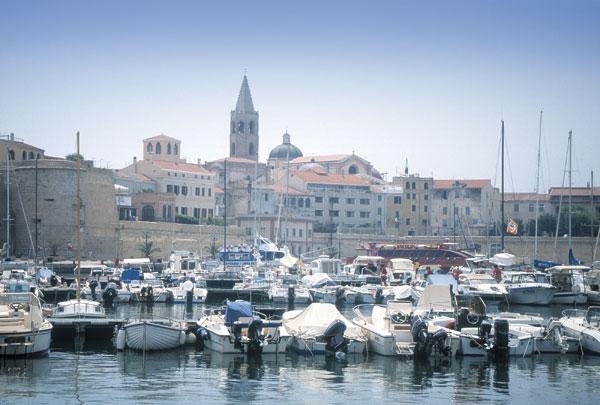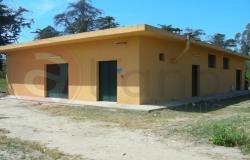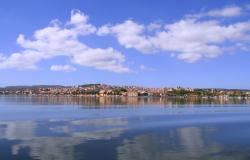Like the fish named after it, Sardinia is slippery and elusive - difficult to catch hold of and pin down. Even DH Lawrence gave up trying to understand the place, deciding it was ‘lost between Europe and Africa and belonging to nowhere.’
Positioned in the centre of the western Mediterranean, Sardinia has evolved a perplexing mixed identity. Mysterious native civilizations met with wave upon wave of plundering invaders, and would-be governors from Lebanon, Tunisia, Spain, and Italy. Add to this jumble of influences the naturally reserved and insular temperament common to islanders everywhere, and it’s little wonder the Sardinians have remained a bit of an enigma to the outside world.
Curious visitors only started finding their way here in the 1960s. The earliest holidaymakers arrived in what is still the island’s most attractive and most visited settlement: Alghero, on the northwest coast.
Situated on a rocky headland, surrounded by stout medieval walls punctuated with bastion towers, Alghero looks from afar like the setting for an exotic fairy tale. Renaissance domes and Venetian bell towers climb above Moorish and Gothic windows set into buildings painted pale pink and yellow. Inside, the centro storico is an entrancing puzzle of tiny lanes - by day an atmospheric place to wander quietly, at night teeming with an entire population enjoying their passeggiata.
A Pocket of Exoticism
While the highly exclusive Costa Smeralda resorts on the other side of the island can seem like a Disney version of the Mediterranean, Alghero is refreshingly uncontrived. An ancient settlement with a thriving fishing port easily capable of sustaining the local economy if all the tourists disappeared, Alghero has genuine character. In fact, in true Sardinian style, it has a multiple personality. The flavours here are of Spanish Catalonia and mainland Italy - making Alghero a pocket of exoticism even within Sardinia.
Archaeological finds suggest indigenous civilizations were in the area from about 6000BC, but Alghero’s last thousand years have been entirely determined by outsiders. The Genoans got here first, creating a fortressed stronghold in the 12th century from which to protect their dominance of the Mediterranean. But when a large Spanish fleet sailed ominously into Alghero’s waters in 1353 and picked a fight, the devastating sea battle that followed moved Alghero into Catalan hands - for 400 years.
Re-christening the town ‘Barcelonetta’, King Pedro IV of Aragon threw the Algherese out of their homes and replaced them with loyal Catalan families. Ethnic Sardinians became second-class citizens. Only a limited number were allowed to enter the town at any one time, and they were obliged to leave when a trumpet signalled. Alghero flourished as an outpost of Catalonia until the 1718 Treaty of London gave all of Sardinia to the Piedmontese, beginning a slow process of Italianization.
Gossip and La Dolce Vita
Modern-day evidence of Alghero’s Catalan past is everywhere. Throughout the old town, brightly painted tiles decorate house-fronts, paella appears on most restaurant menus, and street names prefer carrer to via and plaça to piazza. Eavesdroppers on the conversations of older residents will be surprised to hear gossip swapped in Catalan Spanish rather than in any of the Sardinian dialects of Italian.
As is the case with many of Europe’s more obscure dialects, older generations currently keep Algherese alive, while youngsters turn instead to languages of wider currency - here, standard Italian. Certainly there are enthusiastic twenty- and thirty-something locals now learning their native dialect at evening classes, but the very fact that there is the need for such formal instruction points to the dialect’s almost inevitable demise as living speech.
The language choice of the town’s young reflects the other influence suffusing Alghero. When it’s not busy being Catalan, the town feels rather more like mainland Italy than anywhere else in Sardinia, and it’s often been likened to Sorrento or San Remo. Like their mainland compatriots, the Algherese enthusiastically live the dolce vita. Sardinians are traditionally typified by a quiet dignity and relative seriousness (recall they spawned the word ‘sardonic’, a seriousness even within humour), but the Algherese are intent on enjoying themselves. They wear all the latest fashions, adore the evening passeggiata, and religiously take the daily siesta so as not to miss a minute of night-time fun.
It is true, however, that Alghero maintains a relative tranquillity appropriate to the island. Elsewhere in Italy, such an arrangement of tightly-packed medieval lanes might resound with exuberant calls from balconies to those down below - ‘Paolo! Come stai?’ Here the ancient lanes are quiet except for the occasional buzz of a passing moped. Washing hangs in lazy garlands amongst the Spanish arches bridging the streets. And high above the rooftops, glimpsed unexpectedly at the end of lanes, coloured domes and towers are thrown against a backdrop of blue sky.
Surely the most eye-catching of these domes is the majolica-tiled cupola of San Michele church. Arranged in a pattern of multicoloured diamonds, the tiles give the dome a curious snakeskin texture. Down on street level, San Michele’s flaking façade doesn’t encourage further inspection and admirers of ecclesiastical architecture would be better off visiting Alghero’s cathedral or the 15th-century church of San Francesco, which boasts a Gothic campanile, medieval side-chapels and a Renaissance ceiling. The cathedral - leisurely constructed over 200 years - is similarly mixed in its architecture. Baroque side-chapels sprout outwards from medieval central pillars. Outside, four fluted Neoclassical columns dominate the grandiose white façade.
Local Flavour
In the hot still air of a quiet afternoon, nothing is lovelier than to slip into the cool interior of these sanctuaries or just to sit on their marble steps and watch the unhurried street life pass by. Nightfall, however, draws the eye and mind decidedly elsewhere. Alghero is transformed by night into a buzzing and intensely social place. All of the town spills out onto the narrow stone streets and, like a cork caught in the tide, it is impossible not to bob along in this happy mass perambulation. The lanes lead you into one tiny piazza after another, each fizzing with cafés and bars. People stream out of gelaterie clutching monstrous cones stuffed with fruit and frilled with cream. Shop windows full of locally-made coral jewellery flare a salmon-coloured glow onto the pavement. And every fourth or fifth doorway seems to be a restaurant full of diners.
Excellent food is one thing that proves modern-day Sardinia to be a part of Italy, and, like the mainland, most Sardinian towns have their local specialities. As you’d expect, the Algherese are hugely skilled with seafood, and they make particularly avid use of lobster and bottarga. Bottarga, for anyone unlucky enough not to have encountered it, is a cunning manipulation of mullet or tuna eggs. These are shaped into blocks, dried, hardened and then grated over pasta with olive oil or served as antipasti with prawns, sea truffle, or thin slices of raw fish mixed with slivers of pecorino cheese. All this seafood is washed down very well with one of the excellent white wines produced along Alghero’s coast (or one of the excellent reds, and hang tradition!).
The taste that Alghero leaves in your mouth is nothing if not unique. The precise flavour born out of its fusion of historical influences is found nowhere else. A visit to this magical town is an unforgettable experience, but only part of the greater mystery that is Sardinia itself.
Like the fish named after it, Sardinia is slippery and elusive - difficult to catch hold of and pin down. Even DH Lawrence gave up trying to understand the place, deciding it was ‘lost between Europe and Africa and belonging to nowhere.’
Positioned in the centre of the western Mediterranean, Sardinia has evolved a perplexing mixed identity. Mysterious native civilizations met with wave upon wave of plundering invaders, and would-be governors from Lebanon, Tunisia, Spain, and Italy. Add to this jumble of influences the naturally reserved and insular temperament common to islanders everywhere, and it’s little wonder the Sardinians have remained a bit of an enigma to the outside world.
Curious visitors only started finding their way here in the 1960s. The earliest holidaymakers arrived in what is still the island’s most attractive and most visited settlement: Alghero, on the northwest coast.
Situated on a rocky headland, surrounded by stout medieval walls punctuated with bastion towers, Alghero looks from afar like the setting for an exotic fairy tale. Renaissance domes and Venetian bell towers climb above Moorish and Gothic windows set into buildings painted pale pink and yellow. Inside, the centro storico is an entrancing puzzle of tiny lanes - by day an atmospheric place to wander quietly, at night teeming with an entire population enjoying their passeggiata.
A Pocket of Exoticism
While the highly exclusive Costa Smeralda resorts on the other side of the island can seem like a Disney version of the Mediterranean, Alghero is refreshingly uncontrived. An ancient settlement with a thriving fishing port easily capable of sustaining the local economy if all the tourists disappeared, Alghero has genuine character. In fact, in true Sardinian style, it has a multiple personality. The flavours here are of Spanish Catalonia and mainland Italy - making Alghero a pocket of exoticism even within Sardinia.
Archaeological finds suggest indigenous civilizations were in the area from about 6000BC, but Alghero’s last thousand years have been entirely determined by outsiders. The Genoans got here first, creating a fortressed stronghold in the 12th century from which to protect their dominance of the Mediterranean. But when a large Spanish fleet sailed ominously into Alghero’s waters in 1353 and picked a fight, the devastating sea battle that followed moved Alghero into Catalan hands - for 400 years.
Re-christening the town ‘Barcelonetta’, King Pedro IV of Aragon threw the Algherese out of their homes and replaced them with loyal Catalan families. Ethnic Sardinians became second-class citizens. Only a limited number were allowed to enter the town at any one time, and they were obliged to leave when a trumpet signalled. Alghero flourished as an outpost of Catalonia until the 1718 Treaty of London gave all of Sardinia to the Piedmontese, beginning a slow process of Italianization.
Gossip and La Dolce Vita
Modern-day evidence of Alghero’s Catalan past is everywhere. Throughout the old town, brightly painted tiles decorate house-fronts, paella appears on most restaurant menus, and street names prefer carrer to via and plaça to piazza. Eavesdroppers on the conversations of older residents will be surprised to hear gossip swapped in Catalan Spanish rather than in any of the Sardinian dialects of Italian.
As is the case with many of Europe’s more obscure dialects, older generations currently keep Algherese alive, while youngsters turn instead to languages of wider currency - here, standard Italian. Certainly there are enthusiastic twenty- and thirty-something locals now learning their native dialect at evening classes, but the very fact that there is the need for such formal instruction points to the dialect’s almost inevitable demise as living speech.
The language choice of the town’s young reflects the other influence suffusing Alghero. When it’s not busy being Catalan, the town feels rather more like mainland Italy than anywhere else in Sardinia, and it’s often been likened to Sorrento or San Remo. Like their mainland compatriots, the Algherese enthusiastically live the dolce vita. Sardinians are traditionally typified by a quiet dignity and relative seriousness (recall they spawned the word ‘sardonic’, a seriousness even within humour), but the Algherese are intent on enjoying themselves. They wear all the latest fashions, adore the evening passeggiata, and religiously take the daily siesta so as not to miss a minute of night-time fun.
It is true, however, that Alghero maintains a relative tranquillity appropriate to the island. Elsewhere in Italy, such an arrangement of tightly-packed medieval lanes might resound with exuberant calls from balconies to those down below - ‘Paolo! Come stai?’ Here the ancient lanes are quiet except for the occasional buzz of a passing moped. Washing hangs in lazy garlands amongst the Spanish arches bridging the streets. And high above the rooftops, glimpsed unexpectedly at the end of lanes, coloured domes and towers are thrown against a backdrop of blue sky.
Surely the most eye-catching of these domes is the majolica-tiled cupola of San Michele church. Arranged in a pattern of multicoloured diamonds, the tiles give the dome a curious snakeskin texture. Down on street level, San Michele’s flaking façade doesn’t encourage further inspection and admirers of ecclesiastical architecture would be better off visiting Alghero’s cathedral or the 15th-century church of San Francesco, which boasts a Gothic campanile, medieval side-chapels and a Renaissance ceiling. The cathedral - leisurely constructed over 200 years - is similarly mixed in its architecture. Baroque side-chapels sprout outwards from medieval central pillars. Outside, four fluted Neoclassical columns dominate the grandiose white façade.
Local Flavour
In the hot still air of a quiet afternoon, nothing is lovelier than to slip into the cool interior of these sanctuaries or just to sit on their marble steps and watch the unhurried street life pass by. Nightfall, however, draws the eye and mind decidedly elsewhere. Alghero is transformed by night into a buzzing and intensely social place. All of the town spills out onto the narrow stone streets and, like a cork caught in the tide, it is impossible not to bob along in this happy mass perambulation. The lanes lead you into one tiny piazza after another, each fizzing with cafés and bars. People stream out of gelaterie clutching monstrous cones stuffed with fruit and frilled with cream. Shop windows full of locally-made coral jewellery flare a salmon-coloured glow onto the pavement. And every fourth or fifth doorway seems to be a restaurant full of diners.
Excellent food is one thing that proves modern-day Sardinia to be a part of Italy, and, like the mainland, most Sardinian towns have their local specialities. As you’d expect, the Algherese are hugely skilled with seafood, and they make particularly avid use of lobster and bottarga. Bottarga, for anyone unlucky enough not to have encountered it, is a cunning manipulation of mullet or tuna eggs. These are shaped into blocks, dried, hardened and then grated over pasta with olive oil or served as antipasti with prawns, sea truffle, or thin slices of raw fish mixed with slivers of pecorino cheese. All this seafood is washed down very well with one of the excellent white wines produced along Alghero’s coast (or one of the excellent reds, and hang tradition!).
The taste that Alghero leaves in your mouth is nothing if not unique. The precise flavour born out of its fusion of historical influences is found nowhere else. A visit to this magical town is an unforgettable experience, but only part of the greater mystery that is Sardinia itself.







